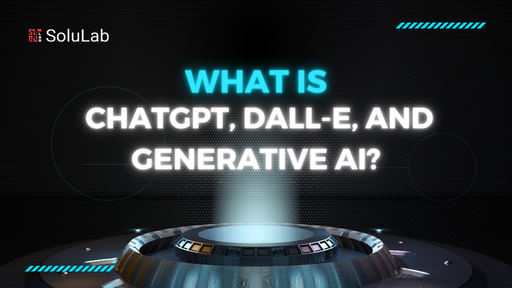Artificial intelligence (AI) has significantly transformed various industries, and one of its fascinating subsets is generative AI. Generative AI encompasses the ability to create new content, ranging from text to images, with remarkable realism and creativity.
This article delves into three prominent examples of generative AI: ChatGPT, DALL-E, and the broader concept of generative AI. We will explore their functionalities, applications, and the ethical considerations surrounding them, paving the way for a future where AI plays a pivotal role in unleashing human-like interactions and fueling innovative content creation.
1. ChatGPT: Engaging Conversations Powered by AI
ChatGPT, developed by OpenAI, represents a significant breakthrough in natural language processing and conversational AI. It is an advanced language model that engages users in interactive and human-like conversations. Deep learning techniques allow ChatGPT to learn grammar, context, and information from vast text data. This extensive training enables it to generate coherent and contextually relevant responses.
The training involves exposure to diverse data sources, including books, articles, and online content, to capture various language patterns and nuances. ChatGPT becomes adept at understanding user queries and providing intelligent responses through this learning process. Its vast applications include customer support chatbots, virtual assistants, and even content generation for various purposes.
Despite its remarkable capabilities, ChatGPT faces certain limitations and challenges. One of the primary concerns is the potential for biases in its responses. Since the model learns from existing data, biases present in the training data can be perpetuated in its output. Addressing this issue requires careful curation of training data and ongoing efforts to ensure fairness and inclusivity in AI systems. Additionally, there is a need to address concerns about the potential misuse or malicious use of ChatGPT, emphasizing the importance of responsible AI development and deployment.
2. DALL-E: Imaginative Image Generation through AI
DALL-E, another remarkable creation by OpenAI, brings generative AI into the realm of image generation. This AI model inputs text prompts and produces unique and visually appealing images based on the provided descriptions. By combining concepts from deep learning and generative AI, DALL-E showcases the potential for AI to excel in creative domains.
The training process for DALL-E involves exposure to an extensive dataset of images and their corresponding textual descriptions. The model learns to associate textual prompts with visual elements and generates images that align with the prompts. This capability opens up exciting possibilities in various industries, such as art, design, advertising, and content creation.
DALL-E has the potential to revolutionize the creative process by automating parts of it and providing inspiration and unique visual concepts. Artists, designers, and advertisers can leverage DALL-E to generate various images tailored to their needs. However, with this exciting potential comes the need to address ethical considerations. Intellectual property rights and ownership of AI-generated content become crucial topics that require thoughtful solutions to protect the interests of creators and uphold fair practices.
3. Generative AI: Expanding the Boundaries of Creativity
Beyond ChatGPT and DALL-E, generative AI development as a broader concept holds immense potential for creativity and innovation. Generative AI refers to the field of AI that focuses on creating new content, such as text, images, music, and more. It leverages deep learning techniques and generative models to simulate human creativity.
Two prominent approaches to generative AI are variational autoencoders (VAEs) and generative adversarial networks (GANs). VAEs aim to capture the underlying latent space of data, allowing for the generation of new samples that align with the learned distribution. On the other hand, GANs involve a competitive learning process between a generator, which produces new content, and a discriminator, which evaluates the authenticity of the generated samples. These generative models have demonstrated exceptional capabilities in creating realistic and diverse content.
The impact of generative AI development extends across numerous industries. In the entertainment sector, generative AI can aid in creating compelling narratives, generating unique characters, and even composing original music. In design and advertising, AI-generated content can offer innovative ideas, streamline the creative process, and deliver personalized experiences to target audiences. However, it is crucial to navigate the ethical considerations surrounding generative AI, including the potential biases in the training data and the accountability for AI-generated content.
Ethical and Social Considerations: Guiding the Future of Generative AI
The rapid advancement of generative AI technology calls for a comprehensive exploration of the ethical and social implications associated with its adoption. Addressing these considerations ensures responsible AI development and deployment while minimizing potential risks and biases.
First and foremost, biases present in training data pose a significant concern. If not properly addressed, these biases can be perpetuated in the output of generative AI models, potentially reinforcing societal stereotypes and inequalities. To mitigate this issue, developers must curate diverse and representative training datasets and implement bias detection and mitigation techniques throughout the training process.
Accountability is another vital aspect to consider. As AI-generated content becomes more prevalent, it is essential to establish clear guidelines and regulations regarding intellectual property rights and ownership. Striking the right balance between encouraging innovation and protecting creative ownership will be crucial to ensure fair practices and prevent the unauthorized use of AI-generated content.
Transparency plays a vital role in building trust and understanding AI-generated outputs. Users should be aware when interacting with AI systems, and efforts should be made to explain or justify the generated content. Transparent AI development and deployment contribute to increased accountability and reduce the potential for misinformation and manipulation.
Conclusion
ChatGPT, DALL-E, and generative AI exemplify the remarkable capabilities of AI in simulating human-like conversations and generating imaginative content. These technologies can potentially transform numerous industries, unleashing creativity and enhancing productivity. However, addressing the ethical considerations surrounding generative AI is crucial to ensure a responsible and inclusive deployment. By fostering transparency, fairness, and accountability, we can harness the transformative power of generative AI for the betterment of society.
As these technologies continue to evolve, a responsible and thoughtful approach is necessary to fully leverage their potential while mitigating potential risks. With continuous advancements and responsible development, ChatGPT, DALL-E, and generative AI are poised to shape the future of AI and human-machine interactions. By carefully considering ethical implications and establishing appropriate guidelines, we can harness generative AI’s transformative power to create a brighter, more innovative future.
Author Bio
Rachita Nayar is a professional writer. She has a penchant for writing and is involved in many projects worldwide. Currently, she works with a blockchain development company in the USA that allowed her to explore the domain and hone her skills further by learning about blockchain and spreading the knowledge.
















